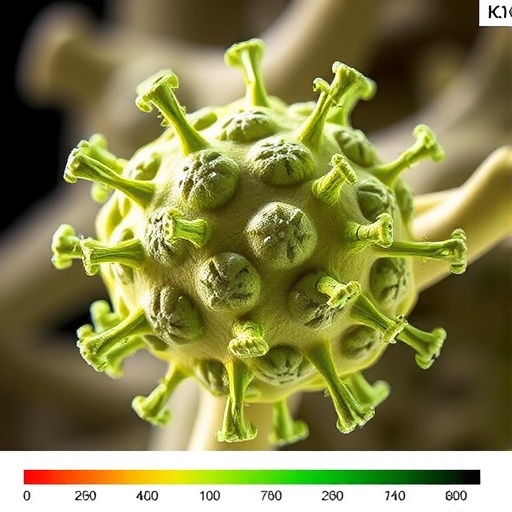A groundbreaking study led by Tsushima and colleagues has shed new light on the genetic dynamics of the wheat pathogen Puccinia triticina, responsible for leaf rust diseases that can devastate wheat crops worldwide. The research utilizes innovative k-mer based Genome-Wide Association Studies (GWAS), revealing a potential avirulence gene that could be crucial in managing disease resistance in wheat. With agricultural yield and food security under constant threat, the implications of such findings could be transformative for future crop management strategies.
The study meticulously examines the genome of Puccinia triticina, identifying structural variations that correlate with the newly identified virulence against the Lr20 resistance gene in wheat. This insight is monumental as it establishes a genetic basis for understanding how this pathogen adapts and evolves in response to the host resistance mechanisms, providing farmers with vital information to combative strategies against crop loss.
The researchers focused on k-mer analysis, a technique that enhances the resolution of the genomic study, allowing for the identification of specific genetic variations associated with virulence factors. Utilizing this advanced methodology, the team was able to pinpoint changes within the pathogen’s genome that were responsible for overcoming the Lr20 resistance. Such detailed understanding of the genetic components involved in pathogenicity is paramount in developing effective breeding programs for disease-resistant varieties.
What sets this study apart is its emphasis on structural genomic variations. Unlike traditional methods that may primarily identify single nucleotide polymorphisms (SNPs), this research highlights larger genomic changes that can significantly impact the organism’s virulence. The ability to explore these broader genomic variations opens up new avenues for targeted research aimed at identifying other potential resistance mechanisms in wheat.
The implications of identifying candidate avirulence genes cannot be overstated. By understanding the specific genetic factors that enable Puccinia triticina to overcome plant defenses, researchers can better predict which strains of the pathogen are likely to emerge and thrive. This proactive approach is essential in an era where climate change is fundamentally altering agricultural landscapes, thus influencing pathogen dynamics and virulence patterns.
Moreover, the incorporation of k-mer based GWAS not only solidifies the relationship between genetic variation and virulence but also exemplifies a growing trend in genomics where computational techniques are synergistically combined with traditional genetic analyses. As the field of plant pathology continues to evolve, this multifaceted approach could serve as a template for future studies seeking to unravel complex genetic interactions between pathogens and their hosts.
As the agricultural community grapples with the pressing need for sustainable practices, findings from this study may offer a beacon of hope. Armed with more precise knowledge about the genetic underpinnings of virulence, breeders can select for traits that enhance resistance to specific pathogenic threats. This capability will ultimately contribute to the sustainability of wheat production in the face of a changing global environment.
Furthermore, the significance of the research extends beyond the confines of academic inquiry. Policymakers and stakeholders across the agricultural spectrum can benefit from understanding how these pathogens operate on a molecular level, aiding in the development of informed strategies that could mitigate crop loss on a global scale. This initiative falls in line with global food security efforts, which are increasingly critical as the world’s population continues to grow.
The findings also highlight the ongoing arms race between plant hosts and their pathogens, drawing attention to the necessity of continued research into plant immunity. As scientists delve deeper into the genetic blueprints of pathogens such as Puccinia triticina, they unearth critical insights that inform resistance breeding, thereby fortifying our food supply against an array of diseases.
In conclusion, the research led by Tsushima et al. marks a significant milestone in our understanding of the genetics of wheat pathogens. By unveiling a candidate avirulence gene and structural variations linked to Lr20 virulence, the study not only enhances the scientific understanding of plant-pathogen interactions but also sets the stage for applied research that can lead to the development of robust, disease-resistant wheat varieties critical for future agricultural sustainability.
This pivotal work emphasizes the power of genomic technologies and their expansive potential to transform agricultural practices. As we look towards the future, the integration of such innovations into disease management strategies will be paramount in promoting resilience within our food systems and ensuring the viability of wheat production in the years to come.
The pursuit of knowledge in the realm of genomics continues to energize researchers and practitioners alike, fostering a collaborative spirit focused on tackling one of humanity’s greatest challenges: feeding a growing population while preserving the health of our ecosystems.
Research like that of Tsushima and his team reminds us of the profound interconnectedness of our agricultural practices, climate, and genetic research, urging us to push the boundaries of what is possible in the quest for sustainable solutions in food production.
By deepening our understanding of the genetic architecture of pathogens and enhancing resistance mechanisms in crops, we can not only safeguard our food supply but also pave the way for a future characterized by sustainable agricultural practices that are resilient in the face of evolving threats.
Subject of Research: Genetic dynamics and virulence mechanisms of the wheat pathogen Puccinia triticina.
Article Title: k-mer-based GWAS reveals a candidate avirulence gene and structural variation in Puccinia triticina linked to gain of Lr20 virulence.
Article References:
Tsushima, A., Morier-Gxoyiya, C., Savva, L. et al. k-mer-based GWAS reveals a candidate avirulence gene and structural variation in Puccinia triticina linked to gain of Lr20 virulence. BMC Genomics 26, 1076 (2025). https://doi.org/10.1186/s12864-025-12230-4
Image Credits: AI Generated
DOI: https://doi.org/10.1186/s12864-025-12230-4
Keywords: wheat, Puccinia triticina, avirulence gene, structural variation, k-mer-based analysis, GWAS, Lr20 resistance, genomic research, plant pathology, agricultural sustainability.




